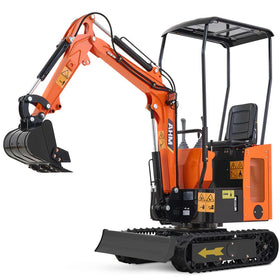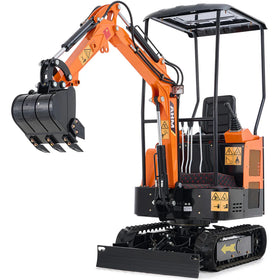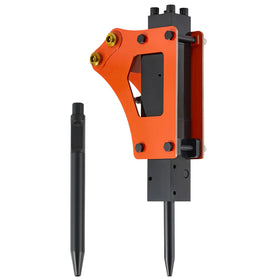1. Introduction
Mini excavators are becoming increasingly important in several industries: especially construction, landscaping, and agriculture. Compact but powerful, these machines can maneuver easily in tight spaces. Moreover, there are a number of perfectly ingenious mini excavator attachments which can turn these machines into multipurpose instruments, capable of performing a wider variety of tasks. This guide will delve into various types of excavator attachments, including buckets, breakers, augers, compactors, grapples, rippers, thumbs, and quick couplers, to help you get some basic knowledge about their respective roles in enhancing the performance of mini excavators.

2. What Are Mini Excavator Attachments?
Mini excavator attachments are tools such as buckets, breakers, augers, and compactors that can be affixed to mini excavators to enable them to perform various additional operations. These attachments for mini excavators include buckets, breakers, augers, compactors, grapples, rippers, thumbs, and quick couplers, each serving a unique purpose to meet the specific demands of different projects.
1. Buckets
Purpose: Buckets are indispensable for a wide range of excavation tasks including digging, grading, and trenching.
Common Types: Standard Digging Buckets: Ideal for general excavation and digging tasks.
Trenching Buckets: Narrow and designed for precise digging of trenches.
Grading Buckets: Wide and flat, perfect for smoothing and leveling surfaces after excavation.
Application: Buckets are versatile tools used across various settings. Typically, standard buckets are perfect for digging foundations, trenching buckets excel in laying pipes or electrical lines, and grading buckets are used for landscape leveling and backfilling.

2. Hydraulic Breakers
Purpose: These powerful attachments are designed to break through concrete, rock, and asphalt effortlessly.
Application: Hydraulic breakers are essential in a variety of settings for different tasks. In quarry settings, hydraulic breakers are often used for breaking large boulders; in construction settings, they are used to remove old concrete structures; in roadwork, for breaking up asphalt.
Related post: Install a Hydraulic Breaker on a Mini Excavator

3. Augers
Purpose: Augers can transform mini excavators into drilling equipment, capable of creating holes for various purposes.
Application: With their spiral drilling function, augers provide clean and precise holes, essential for setting fence posts, planting trees, and installing outdoor structures.
4. Compactors
Purpose: Compactors are crucial for the compaction of soil, gravel, and sand, which is a necessary step in many construction and roadwork projects.
Application: By compacting ground material, these attachments prepare a stable, dense foundation. They are particularly useful in road construction and building projects where a solid base is required.

5. Grapples
Purpose: Grapples are critical for handling and sorting irregularly shaped objects or debris.
Common Types:
Rotating Grapples: These allow for 360-degree manipulation of materials, making them ideal for precise placement and sorting operations.
Fixed Grapples: Offer strength and durability for heavy lifting and moving of large objects where precision is less critical.
Application: Grapples are extensively used in logging, waste management, and construction to move or load materials such as logs, rocks, scrap metal, and other bulky items.

6. Rippers
Purpose: Rippers are designed to penetrate and break up hard, compacted surfaces such as frozen ground, packed gravel, or tough soil.
Application: Ideal for agriculture, construction, and landscaping, rippers help in efficiently breaking up soil, facilitating the planting process, or the installation of infrastructure like pipes and cables.

7. Thumbs
Purpose: Thumbs work in tandem with buckets to significantly expand the range of materials that can be handled. They allow the mini excavator to grasp large, bulky items, such as boulders, tree stumps, and construction debris.
Application: Thumbs increase the versatility of the excavator, enhancing its ability in demolition and sorting tasks, and are particularly useful in disaster clean-up and site preparation.
8. Quick Couplers
Purpose: Quick couplers are designed to facilitate the rapid exchange of various attachments without the need for additional tools or significant downtime.
Application: By enabling quick and easy attachment changes, quick couplers minimize transition times and maximize operational efficiency. This allows operators to move seamlessly between tasks such as digging, grading, and compacting.

3. Choosing Your Ideal Types of Attachments for Mini Excavators
As you can see, different attachments for mini excavators can have different features. Here are some factors that you can consider when you are trying to choose your ideal types of mini excavator attachments:
1. Task-Specific Requirements: Identifying the primary purpose of the task can help in choosing the attachment that is best suited for your job. For example, digging foundations, trenching for pipes, grading, or landscaping demand distinct attachment types.
2. Consider the Materials and Job Site Conditions: The type of material you plan to work with (e.g., soil, rock, concrete) and the conditions at the job site (e.g., space constraints, ground conditions) should guide your choice of attachments.
3. Excavator Model Compatibility: Not all attachments fit all excavators. Check the hydraulic capacity and attachment coupling system of your excavator to ensure compatibility.
4. Cost-Benefit Analysis: Renting or buying attachments could be very costly. It is important to consider the potential frequency of use of the machinery, and also the project duration when considering whether to buy or rent excavator attachments. For one-time or infrequent usage, renting can be cost-effective. On the other hand, buying new mini excavator attachments can be preferable for regular usage.
4. How to Maintain Mini Excavator Attachments?
Ensuring the longevity and optimal performance of your mini excavator attachments requires strict adherence to comprehensive maintenance routines and safety protocols. Proper care not only extends the life of your equipment but also enhances operational safety. Maintenance of excavator attachments should not be overlooked. Here are some key practices:
Lubrication: Regular lubrication of all moving parts is crucial. This practice helps to reduce friction and wear, and can significantly prolong the lifespan of the attachments.
Inspection: Periodic inspections are vital to maintaining the integrity of your attachments. Look for signs of wear and tear, such as cracks, dents, or unusual noises. Early detection of these issues is essential for preventing costly repairs and potential downtime. Implement a checklist system to ensure no component is overlooked during inspection.
Storage: When not in use, attachments should be stored properly to prevent exposure to harsh weather conditions that can lead to rust and corrosion. A clean, dry, and ventilated area is ideal for storage. Covering the attachments can also protect them from dust and debris, which can clog moving parts and lead to premature failure.
Related post: Maximizing Compact Excavator Uptime

5. The Future Development of Mini Excavator Attachments
The outlook for mini excavator attachments is promising, with the ongoing technological advancements and market trends shaping the development of these essential tools:
Technological Advancements
Technological progress is at the forefront of transforming mini excavator attachments:
Automation: The use of mini excavator attachments is being revolutionized by the incorporation of automated technologies. These technologies minimize labor costs and human error by streamlining operations, improving precision in jobs, and drastically reducing the amount of manual work needed.
Hydraulic Efficiency: Recent developments in hydraulic technology not only boost the power and speed of attachments but also enhance their efficiency and reliability. They are designed to be more robust and environmentally friendly, minimizing hydraulic fluid leaks and optimizing fuel consumption.
Smart Attachments: The adoption of smart technologies, including sensors and the Internet of Things (IoT), is also becoming popular. These technologies enable the attachments to collect and analyze data in real time, facilitating unprecedented levels of performance monitoring and maintenance predictability.
Market Trends
Market dynamics are also guiding the evolution of these attachments, reflecting environmental priorities and flexibility:
Environmental Sustainability: The push towards sustainability is influencing the design and functionality of mini excavator attachments. New models are expected to disturb less soil during operations, produce fewer emissions, and operate more quietly, thereby adhering to stricter environmental regulations and contributing to greener construction practices.
Customization and Flexibility: As projects become more varied and technically demanding, the ability to customize attachments to specific tasks becomes more valuable. Manufacturers are responding by offering modular systems that can be tailored to different conditions and tasks, ranging from urban construction to rural landscaping, enhancing the utility and appeal of mini excavators.
Conclusion
The versatility and utility of mini excavator attachments cannot be overstated. With the best attachments for mini excavators, operators can tackle lots of tasks, increasing productivity and efficiency on the job site. By assessing your needs and exploring the various attachments available, you can ensure that your mini excavator operates at its full potential. If you are looking for good mini excavator attachments for sale now, just visit Ahmcorp to check more information!







